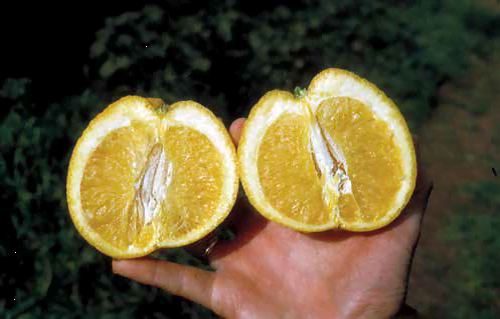Table of contents of the article
ToggleLemongrass disease is a physiological disease that affects the quality of lemon fruits, causing deformities and damage to the fruits. This article from the “WORLD OF PLANTS” website provides an explanation of the causes of stubborn disease in lemon fruits and effective methods of prevention and treatment.
Causes of stubborn disease in lemon fruits
- Disease name: Lemon stubbornness disease
- Scientific name: Spiroplasma citri
- Type of disease: bacterial
- Disease family: Spiroplasmataceae
The disease is caused by bacteria that do not have a cell wall and live in the phloem sieve tubes of infected lemon plants. The bacteria multiply in leafhoppers, which are considered the carrier of this disease. Symptoms continue to appear even after treating the infected trees, hence the disease’s name.
Symptoms of stubborn disease in lemon fruits
The similarity of the symptoms of this disease to other diseases makes it difficult to detect in the field, so laboratory testing is required. One of the most important visual symptoms is the small size of the leaves and their straight growth. Old trees may not show any symptoms, while others or part of the tree may have them. It shows symptoms, as the disease does not spread well within the tree, and flowering can occur out of season, which may lead to the appearance of fruits of uneven maturity on the affected tree or part of the tree. The lemon fruits that are produced are likely to be small and unbalanced and may It has a bitter flavour, and the seeds found in lemon fruits fall off.

Development cycle of stubborn disease in lemon fruits
Analysis shows that bacteria are transferred primarily from weeds to lemon plants and secondarily from one lemon plant to another. After conducting laboratory tests based on culturing bacteria from plant or reproductive tissues, the results take 2 to 3 weeks. Therefore, it is recommended to perform a PCR test that is more sensitive than the traditional method because It can detect bacteria in a sample at low concentrations.
Suitable conditions for the spread of stubborn disease in lemon fruits
Hot and dry weather helps the development and spread of Spiroplasma citri bacteria, as they settle in warm indoor growing areas. They may be found in humid environments, but their presence is minimal, as they require a temperature ranging between (25 - 30) degrees Celsius.

Losses resulting from the spread of stubborn disease in lemon fruits
Disease is more of a problem in young orchards than in mature orchards. Stunted growth and reduced lemon production will usually continue throughout the life of the tree, but older trees often have low production and drop fruit.
Controlling stubborn disease in lemon fruits
- Graft the infected plant with healthy shoots and use shoots and grafting materials that are free of pathogens.
- Remove infected trees and replant them with disease-free trees.
- Proper use of tetracycline may be useful in treating the disease.
Preventive measures for stubborn disease in lemon fruits
- Obtain seedlings from an area free of disease.
- Weed control in and around the lemon field.
- Sterilize agricultural tools constantly to avoid transmission of the disease from one field to another or plant to another.
- Follow up on the crop if any unusual symptoms or signs appear.
In conclusion, we would like to note that we, at the world of plants website, offer you all the necessary services in the world of plants, we provide all farmers and those interested in plants with three main services::-
- Artificial intelligence consulting service to help you identify diseases that affect plants and how to deal with them.
- Blog about plants, plant diseases and care of various crops ... You are currently browsing one of her articles right now.
- An application that provides agricultural consultations to clients, as well as a service for imaging diseases and knowing their treatment for free – Click to download the Android version from Google Play Store، Click to download the IOS version from the Apple App Store.
Sources:
Citrus Stubborn Disease Pest Profile – State of California
Stubborn Disease – UNIVERSITY OF CALIFORNIA AGRICULTURE AND NATURAL RESOURCES




